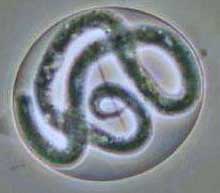Filariasis-Related Eye Disease: A Rare but Serious Condition in Vietnam
 |
|
Onchocerca |
Dr. Hoang Anh Tuan from the Central Eye Hospital reports that they frequently receive patients suffering from conjunctivitis, eyelid granulomas, and hemorrhages. Recently, a 50-year-old patient, N.T.C., from Coc Phong, Chi Tan, Khoai Chau, Hung Yen, was admitted with discomfort in the right eye. Upon examination, a rapidly growing red mass was found in the outer corner of the conjunctiva. While initial clinical assessments and other diagnostic tests were inconclusive, histopathological examination revealed a fibrous capsule, followed by granulation tissue with neovascularization and various inflammatory cells including neutrophils, lymphocytes, giant foreign body cells, and cross-sections of worms with thick chitinous shells containing Onchocerca larvae.
Another case involved a 50-year-old patient, T.T.S., from organization 18D in Tuong Mai Ward, Hai Ba Trung District, Hanoi. Ten days before admission, the patient experienced swelling of the upper eyelid on the right side, which did not improve with topical antibiotic treatment (Cylaxan). Upon examination at the Central Eye Hospital, a 0.5 cm firm, mobile, and non-tender mass was found in the upper eyelid, along with mild conjunctival hemorrhage. The patient underwent surgical removal of the mass. During the procedure, using Cocher forceps to dissect the tumor, a yellowish mucous substance was released, along with live worms that were still wriggling. The doctors retrieved two 4 cm long worms with thick chitinous shells, containing numerous Thelazia larvae. These two cases exemplify the detection and successful treatment of filarial eye disease at the Central Eye Hospital.
In some regions of West Africa, South America, Guatemala, and Mexico, parasitic eye diseases are relatively common, particularly those caused by filarial worms. However, there has not been any research in Vietnam addressing this condition. Despite this, many individuals may be affected without being diagnosed. According to ophthalmologists, eye diseases caused by worms can lead to severe consequences such as diminished vision or even blindness. Types of Parasites Causing Eye Diseases include the protozoa Acanthamoeba, Toxoplasma, and various helminths. Filarial worms in the eye can cause eyelid swelling, conjunctivitis, keratitis, uveitis, retinitis, vitreous opacities, and optic nerve atrophy.
Treatment for cases of filarial eye disease primarily involves surgery. Surgical intervention not only aids in diagnosis but also helps remove the parasitic structures. Following surgery, additional medication may be effective in eliminating any remaining worms, as the medication can target those that were not completely removed during the operation. The commonly used medication is diethylcarbamazine at a dosage of 3-6 mg/kg/24 hours for five consecutive days.
Filariasis-related eye disease is rare, making the precise identification of the causative worm quite challenging. To accurately diagnose the type of worm responsible for the disease, specialists must rely on epidemiological factors, clinical symptoms, histopathological examinations, parasitological tests, antigen-antibody reactions, and PCR techniques. This comprehensive approach facilitates effective treatment strategies.


















































